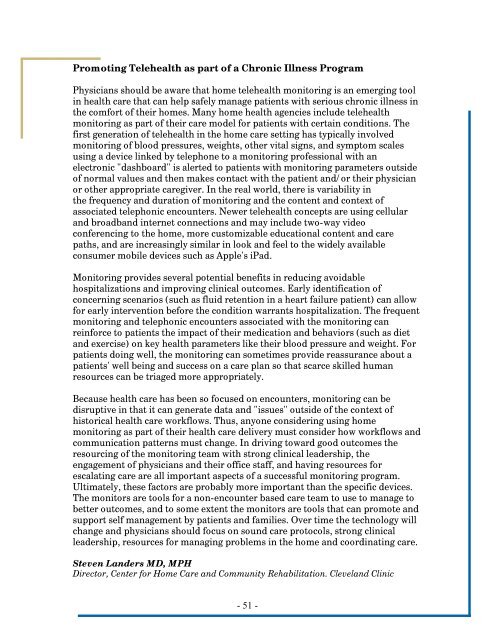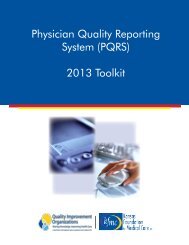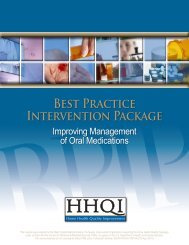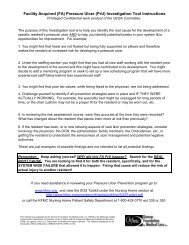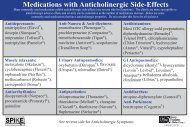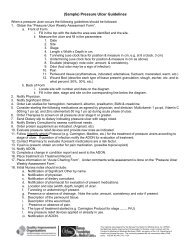Best Practice Intervention Package - Kansas Foundation for Medical ...
Best Practice Intervention Package - Kansas Foundation for Medical ...
Best Practice Intervention Package - Kansas Foundation for Medical ...
- No tags were found...
You also want an ePaper? Increase the reach of your titles
YUMPU automatically turns print PDFs into web optimized ePapers that Google loves.
Promoting Telehealth as part of a Chronic Illness ProgramPhysicians should be aware that home telehealth monitoring is an emerging toolin health care that can help safely manage patients with serious chronic illness inthe com<strong>for</strong>t of their homes. Many home health agencies include telehealthmonitoring as part of their care model <strong>for</strong> patients with certain conditions. Thefirst generation of telehealth in the home care setting has typically involvedmonitoring of blood pressures, weights, other vital signs, and symptom scalesusing a device linked by telephone to a monitoring professional with anelectronic "dashboard" is alerted to patients with monitoring parameters outsideof normal values and then makes contact with the patient and/or their physicianor other appropriate caregiver. In the real world, there is variability inthe frequency and duration of monitoring and the content and context ofassociated telephonic encounters. Newer telehealth concepts are using cellularand broadband internet connections and may include two-way videoconferencing to the home, more customizable educational content and carepaths, and are increasingly similar in look and feel to the widely availableconsumer mobile devices such as Apple's iPad.Monitoring provides several potential benefits in reducing avoidablehospitalizations and improving clinical outcomes. Early identification ofconcerning scenarios (such as fluid retention in a heart failure patient) can allow<strong>for</strong> early intervention be<strong>for</strong>e the condition warrants hospitalization. The frequentmonitoring and telephonic encounters associated with the monitoring canrein<strong>for</strong>ce to patients the impact of their medication and behaviors (such as dietand exercise) on key health parameters like their blood pressure and weight. Forpatients doing well, the monitoring can sometimes provide reassurance about apatients' well being and success on a care plan so that scarce skilled humanresources can be triaged more appropriately.Because health care has been so focused on encounters, monitoring can bedisruptive in that it can generate data and "issues" outside of the context ofhistorical health care workflows. Thus, anyone considering using homemonitoring as part of their health care delivery must consider how workflows andcommunication patterns must change. In driving toward good outcomes theresourcing of the monitoring team with strong clinical leadership, theengagement of physicians and their office staff, and having resources <strong>for</strong>escalating care are all important aspects of a successful monitoring program.Ultimately, these factors are probably more important than the specific devices.The monitors are tools <strong>for</strong> a non-encounter based care team to use to manage tobetter outcomes, and to some extent the monitors are tools that can promote andsupport self management by patients and families. Over time the technology willchange and physicians should focus on sound care protocols, strong clinicalleadership, resources <strong>for</strong> managing problems in the home and coordinating care.Steven Landers MD, MPHDirector, Center <strong>for</strong> Home Care and Community Rehabilitation. Cleveland Clinic- 51 -


